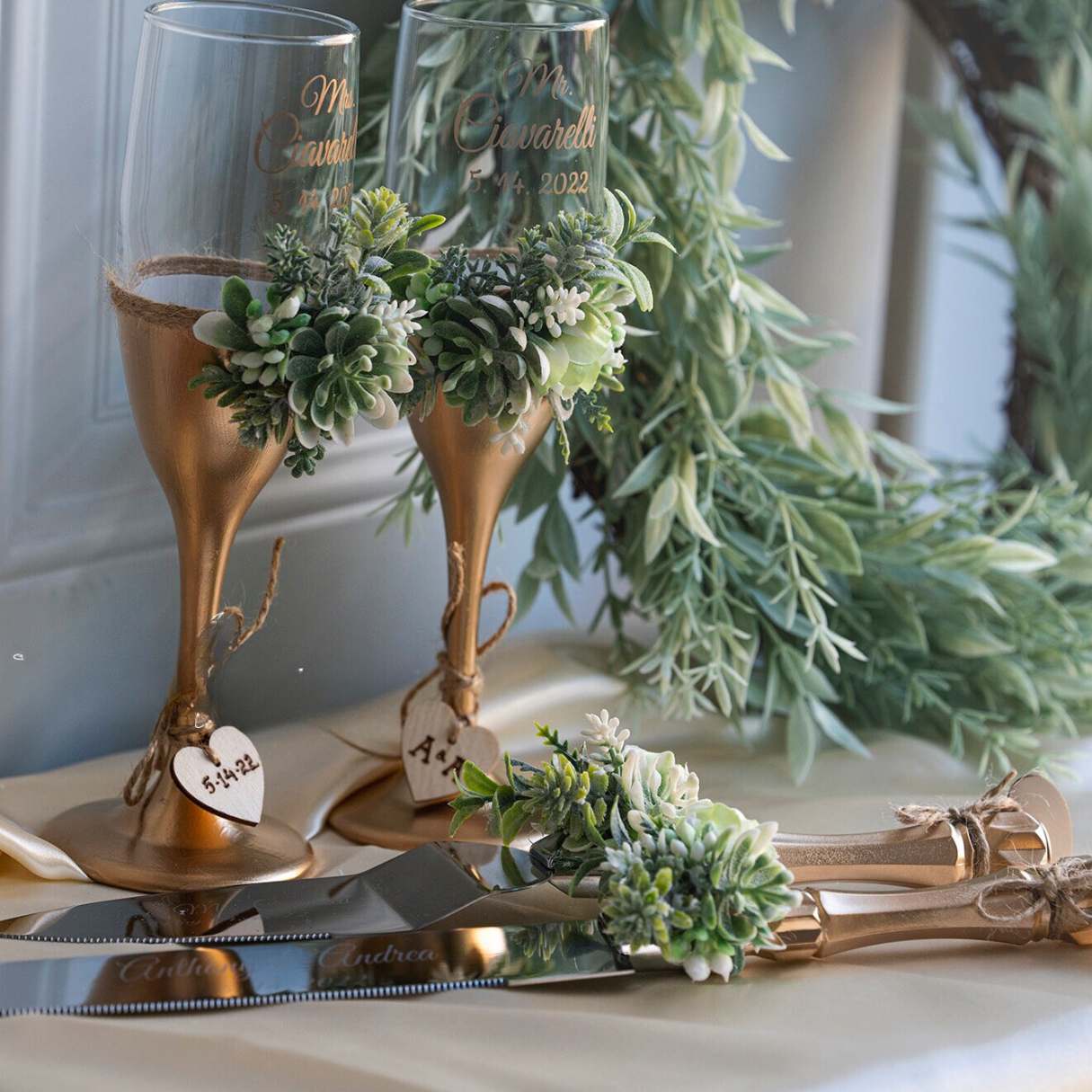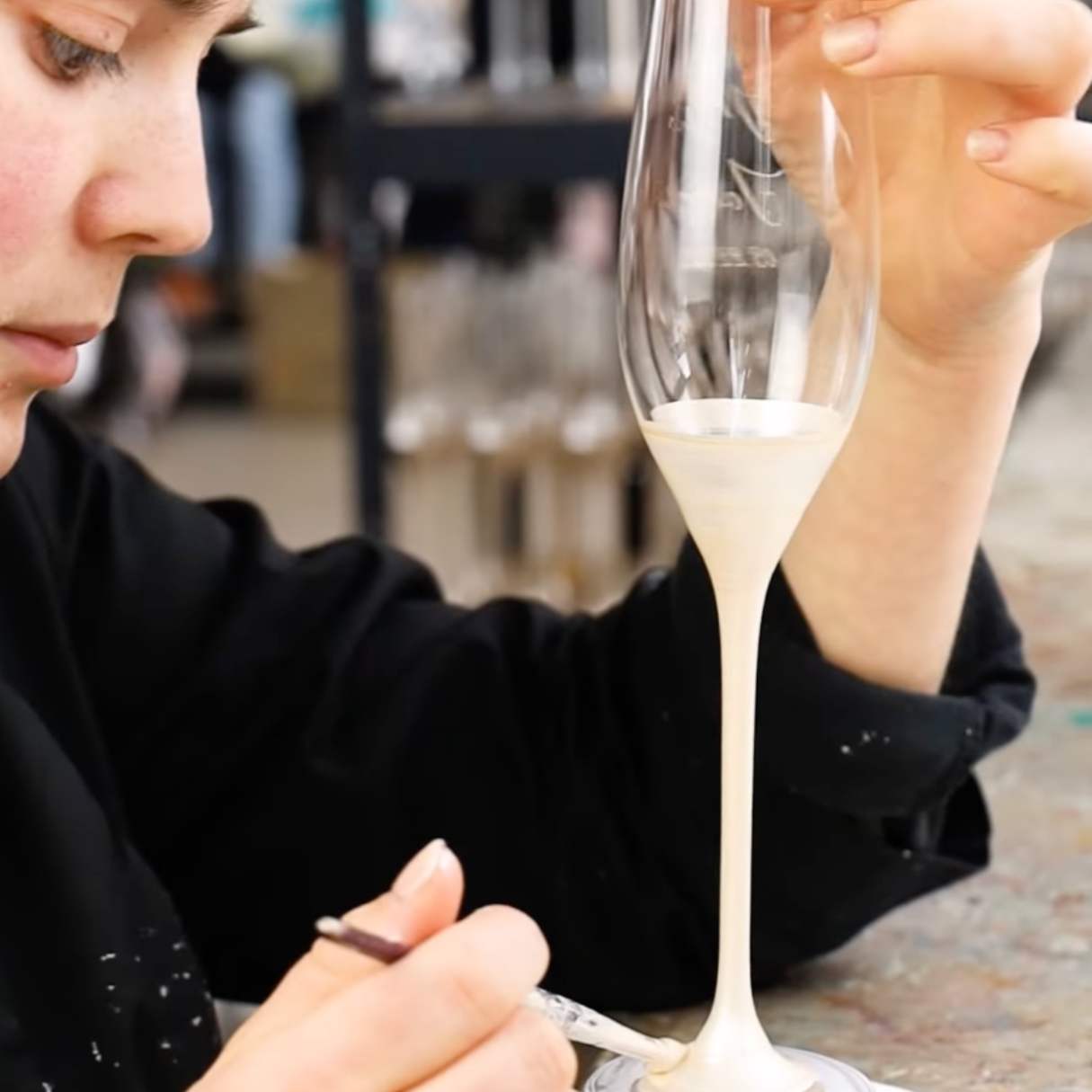

Tableware
How To Clean Champagne Flutes
Modified: January 5, 2024
Learn the best way to clean your champagne flutes and keep your tableware sparkling with our easy-to-follow step-by-step guide.
(Many of the links in this article redirect to a specific reviewed product. Your purchase of these products through affiliate links helps to generate commission for Storables.com, at no extra cost. Learn more)
Introduction
Welcome to the world of champagne flutes! Whether you’re celebrating a special occasion or simply indulging in a glass of bubbly, champagne flutes are a staple in any tableware collection. These elegant and delicate glasses are designed to enhance the experience of drinking champagne, with their long, slender stems and tall, narrow bowls that allow the bubbles to rise and capture the aroma.
While champagne flutes add a touch of sophistication to any celebration, they do require special care and attention when it comes to cleaning. The intricate shape and fragile nature of these glasses can make the cleaning process a bit daunting. However, with the right materials and techniques, you can keep your champagne flutes looking sparkling clean and ready for your next toast.
In this article, we will guide you through the step-by-step process of cleaning champagne flutes, ensuring that you maintain their pristine condition and prolong their lifespan. So, let’s dive in and learn how to give your champagne flutes the TLC they deserve!
Key Takeaways:
- Keep your champagne flutes sparkling by rinsing with warm water, using a soft sponge, and being gentle with the delicate stems. Thoroughly rinse and dry to maintain their elegance for years to come.
- Optional polishing with a glass polishing cloth, vinegar solution, or baking soda paste can give your champagne flutes an extra shine. Regular cleaning and care will preserve their beauty and clarity.
Materials Needed
Before we begin cleaning your champagne flutes, let’s gather all the necessary materials. Having these items on hand will make the cleaning process much more efficient and effective:
- Warm water
- Mild dish soap
- Soft sponge or cloth
- Microfiber cloth or soft towel
- Optional: glass polishing cloth or specialized glass cleaning solution
- Optional: rubber bands or wine glass drying rack
These materials are easily accessible and can be found in most households. If you don’t have microfiber cloth or specialized glass cleaning solution, a soft towel or cotton cloth will work just fine. The rubber bands or wine glass drying rack can be used to hold the flutes upside down for drying, but they are not essential.
Now that we have all the necessary materials, let’s move on to the step-by-step cleaning process for champagne flutes.
Step 1: Rinse with Warm Water
The first step in cleaning your champagne flutes is to give them a thorough rinse with warm water. This step helps to remove any leftover champagne residue and prevents it from drying and hardening, making the cleaning process easier.
Start by filling your sink or a basin with warm water. Make sure the water is not too hot, as extreme temperatures can damage delicate glassware. Gently place the champagne flutes into the water, one at a time, and swish them around to loosen any debris.
Allow the flutes to soak in the warm water for a few minutes. This will help to further loosen any stubborn residue. If there are any visible stains or spots on the glasses, you can use a soft sponge or cloth to gently scrub the affected areas.
Once you’re satisfied with the rinse, carefully remove the flutes from the water and place them on a clean towel or dish rack to air dry. Avoid using paper towels or abrasive materials, as they can scratch the glass. You can now move on to the next step in the cleaning process.
Step 2: Use a Soft Sponge or Cloth
After rinsing your champagne flutes with warm water, it’s time to move on to the actual cleaning process. For this step, you will need a soft sponge or cloth to gently clean the inside and outside of the flutes.
Take your soft sponge or cloth and wet it with warm water. Make sure to wring out any excess water, as you want it to be damp, not soaking wet. This helps to prevent excessive moisture from seeping into the stem or base of the flute, which can potentially loosen it from the bowl.
Starting from the rim of the flute, gently wipe the inside and outside surfaces in a circular motion. Be sure to pay extra attention to any areas where residue or stains may be present. If there are any stubborn spots that are harder to remove, you can apply a small amount of mild dish soap to the sponge or cloth and continue to clean those areas.
Remember to be gentle while cleaning to avoid any accidental breakage. Champagne flutes are delicate, and too much pressure can cause them to chip or shatter. Take your time and maintain a careful, light touch throughout the cleaning process.
Once you have thoroughly cleaned the flutes, rinse them with warm water again to remove any traces of soap residue. Make sure to rinse both the inside and outside of the glasses.пїст
Step 3: Clean with Mild Dish Soap
Now that you have rinsed the champagne flutes and wiped them with a soft sponge or cloth, it’s time to give them a more thorough cleaning using mild dish soap. This step will help remove any remaining residue and ensure that your flutes are impeccably clean.
While cleaning with soap, it’s crucial to choose a mild dish soap rather than a strong detergent. Harsh chemicals can damage the delicate glass and leave behind a soapy residue that affects the taste and appearance of your champagne.
To begin, dampen your sponge or cloth with warm water and apply a small amount of dish soap. Gently lather the sponge or cloth, ensuring that the soap is evenly distributed.
Starting from the rim, once again, gently clean the entire surface of the flute, including both the inside and outside. Pay close attention to the base and stem of the glass, as they can accumulate dirt and grime.
Take care not to scrub too forcefully or use abrasive materials, as this can lead to scratches or damage the glass. Instead, use light, circular motions to ensure a thorough yet gentle cleaning.
Once you’re satisfied with the cleaning, rinse the flutes with warm water to remove any traces of soap. Make sure to rinse both the inside and outside of the glasses thoroughly to ensure that no soap residue remains.
Now that your champagne flutes are clean and free from any soapy residue, it’s time to move on to the next step: being gentle with the stems.
To clean champagne flutes, use warm water and mild dish soap. Gently hand wash the flutes, taking care not to twist the delicate stems. Rinse thoroughly and air dry upside down to prevent water spots.
Read more: What Are Champagne Flutes?
Step 4: Be Gentle with the Stems
When cleaning champagne flutes, it’s essential to pay special attention to the stems, as they are delicate and prone to breakage. The slender design of the stems adds elegance to the overall appearance of the flute, but it also requires extra care during the cleaning process.
To start, hold the flute by the bowl, avoiding the stem as much as possible. The oils from your hands can transfer to the stem and leave fingerprints or smudges. By holding the bowl, you can minimize contact with the stem and maintain its pristine appearance.
When cleaning the stem, use a gentle touch and avoid applying excessive pressure. The stems are thinner and more fragile compared to the bowl, so any rough handling can result in bending or even snapping. Ensure that your sponge or cloth is soft and clean to prevent any abrasive action against the stem.
Work your way along the stem, paying close attention to any areas where dirt or residue may have accumulated. Use gentle, circular motions to remove any debris or stains, taking care not to twist or bend the stem in the process.
If you notice stubborn stains or residue that won’t come off easily, wrap a soft cloth around the stem and hold it gently while cleaning. This can provide extra support and prevent accidental breakage while still allowing you to clean effectively.
Once you have finished cleaning the entire stem, give it a final rinse with warm water to remove any remaining cleaning solution or residue. Make sure to thoroughly rinse both the stem and the rest of the flute before moving on to the next step.
Now that you have gently cleaned the stems of your champagne flutes, it’s time to proceed with the rinsing process and ensure that all traces of soap are removed.
Step 5: Rinse Thoroughly
After cleaning your champagne flutes and giving extra care to the delicate stems, it’s important to rinse them thoroughly to ensure that all traces of soap and residue are removed.
Start by holding each flute under a stream of warm water, ensuring that the water reaches both the inside and outside surfaces of the glass. Use your fingers to gently swirl the water around the bowl, allowing it to rinse away any remaining soap or debris.
Continue rinsing until the water runs clear, indicating that the flutes are free from any traces of soap. You can also hold the flutes up to the light to check for any spots or streaks that may have been missed during the cleaning process.
Be thorough in your rinsing process, paying close attention to the base, stem, and rim of the flutes. These areas can often collect residue, so give them a little extra attention to ensure they are completely clean before moving on to the next step.
If you’re concerned about water spots or mineral deposits, you can use distilled water for the final rinse. Distilled water has fewer minerals compared to tap water, reducing the likelihood of leaving behind unsightly spots or streaks on your freshly cleaned flutes.
Once you have rinsed the flutes thoroughly and are confident that all the soap has been removed, it’s time to move on to the drying process, which is essential for maintaining the clarity and sparkle of your champagne flutes.
Step 6: Air Dry or Use a Soft Cloth
Now that your champagne flutes have been rinsed thoroughly, it’s time to dry them properly to prevent any water spots or streaks from forming. There are two common methods for drying champagne flutes: air drying and using a soft cloth.
If you have the time and space, air drying is a simple and effective option. Place the rinsed flutes upside down on a clean, dry towel or dish rack to allow the water to drain out. The inverted position helps to prevent any water droplets from settling inside the flute. Ensure that the flutes are stable and won’t tip over while they are drying.
It’s important to note that when air drying champagne flutes, you should avoid stacking them directly on top of one another. This can lead to instability and potential breakage. If you need to dry multiple flutes, arrange them in a single layer to ensure even airflow around each glass.
If you prefer a faster drying method or want to avoid potential water spots, you can use a soft cloth to dry your champagne flutes. Choose a clean, lint-free cloth, such as a microfiber cloth or a soft towel.
Gently pat the inside and outside of each flute, ensuring that you reach all the nooks and crannies. Be careful not to apply excessive pressure, as this can cause the delicate glass to chip or break. Take your time and be thorough in your drying process.
If you notice any remaining water spots or streaks after drying, you can use a specialized glass polishing cloth or a gentle glass cleaner to gently buff the flutes. Follow the manufacturer’s instructions for the specific product you are using, and remember to be gentle to avoid damaging the glass.
Whether you choose to air dry or use a soft cloth, ensure that your champagne flutes are completely dry before storing or using them to prevent any moisture buildup that could lead to mold or damage.
Now that your champagne flutes are dry and sparkling, you may want to take one step further and polish them to achieve a flawless, crystal-clear appearance.
Step 7: Polishing the Flutes (Optional)
Set your table with elegance by polishing your champagne flutes. This can give them an extra shine and a pristine look. While this step is optional, it can significantly elevate the visual appeal of your flutes, especially for special occasions or when you want to impress your guests.
There are a few different methods you can use to polish your champagne flutes, depending on the materials you have available:
1. Glass Polishing Cloth: Start by ensuring that your flutes are completely dry. Then, use a specialized glass polishing cloth to gently buff the surface of each flute. Apply even pressure and use circular motions to achieve an even shine. Avoid using excessive force, as this can damage the delicate glass. Make sure to polish both the inside and outside of each flute for consistent results.
2. Vinegar Solution: Create a vinegar solution by mixing equal parts of white vinegar and water. Dampen a soft cloth with the solution, and gently polish the surface of each flute. The mild acidity of the vinegar helps to remove any mineral deposits or stubborn stains. Rinse the flutes with warm water after polishing to remove any vinegar residue.
3. Baking Soda Paste: Make a paste by mixing baking soda with a small amount of water until it forms a thick consistency. Apply the paste to a soft cloth and gently rub it onto the surface of each flute in a circular motion. The baking soda acts as a gentle abrasive and helps to remove any lingering stains or residue. Rinse the flutes thoroughly with warm water to remove any traces of the paste.
Remember to follow the manufacturer’s instructions for any specialized cleaning or polishing products you may be using. Always be gentle and take your time during the polishing process to avoid any damage to the fragile glass.
Once you have finished polishing your champagne flutes, give them a final rinse with warm water to remove any polishing residue. Then, allow them to air dry or use a soft cloth to dry them before storing them away or using them for your next celebration.
By following these steps and giving your champagne flutes the care and attention they deserve, you can ensure that they remain in excellent condition, ready to be used and enjoyed for many more celebratory toasts to come.
Read more: Why Are Champagne Flutes Tall?
Conclusion
Cleaning champagne flutes may seem like a daunting task, but with the right materials and techniques, it becomes a simple and satisfying process. By following the steps outlined in this guide, you can keep your champagne flutes looking sparkling clean and maintain their elegance for years to come.
Start by rinsing the flutes with warm water to remove any residue and then use a soft sponge or cloth to gently clean both the inside and outside surfaces. Be extra careful when cleaning the delicate stems, as they require a gentle touch to avoid breakage.
Next, use mild dish soap to thoroughly clean the flutes, paying attention to any stubborn stains or residue. Rinse the flutes with warm water to remove all traces of soap and never forget to rinse the stems as well.
Once the cleaning process is complete, it’s essential to rinse the flutes thoroughly to ensure that no soap or residue remains. Take care to rinse the base, stem, and rim of the flutes to ensure complete cleanliness.
Drying the flutes properly is crucial to prevent water spots or streaks. You can either air dry them by placing them upside down on a clean towel, or use a soft cloth to gently pat them dry.
If you desire an extra polished appearance, you have the option to use a glass polishing cloth, vinegar solution, or baking soda paste to achieve a flawless shine on your flutes. However, polishing is an optional step and can be omitted if you are satisfied with the cleanliness of your glasses.
By following these steps and incorporating regular cleaning into your routine, you can preserve the beauty and clarity of your champagne flutes. Whether you’re celebrating a special occasion or simply indulging in some well-deserved self-care, knowing that your champagne flutes are clean and ready for use adds an extra touch of elegance to the experience.
So, raise your flutes, toast to the joyous moments in life, and savor every sip of your favorite bubbly, knowing that your champagne flutes are in tip-top shape.
Frequently Asked Questions about How To Clean Champagne Flutes
Was this page helpful?
At Storables.com, we guarantee accurate and reliable information. Our content, validated by Expert Board Contributors, is crafted following stringent Editorial Policies. We're committed to providing you with well-researched, expert-backed insights for all your informational needs.














0 thoughts on “How To Clean Champagne Flutes”